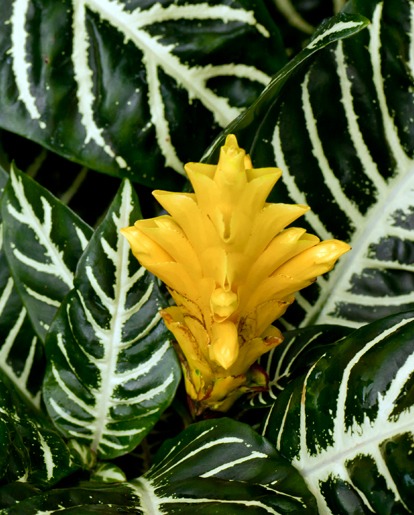Zebra Plant – Exotic Striped Foliage
This tropical evergreen plant is best grown as a houseplant. Potted plants grow to 15 inches (38 cm), ideal for pots that are 6 inches (15 cm) in diameter.
Large pointed leaves are dark, glossy green with exotic, creamy-white stripes. They are oval in shape with a pointy tip, and grow in pairs on a thick, purple tinted stem.
Blooming Aphelandra produce a showy plume of yellow bracts from which emerge delicate yellow tubular flowers. The flowers only last for a few days, while the bracts persist for four to eight weeks.
After the bracts fade, cut them off and allow the plant to rest in a
 cool room for approximately
two months. Move the Zebra Plant to a bright indoor location in the
late spring, when light becomes more abundant (avoid direct sunlight).
cool room for approximately
two months. Move the Zebra Plant to a bright indoor location in the
late spring, when light becomes more abundant (avoid direct sunlight).It can also be moved to a shady outdoor location, such as a porch or patio.
When exposed to bright light for three months, Aphelandra squarrosa will typically rebloom in the fall. Flowering is triggered by light intensity, not the length of day.
While the Zebra Plant will not bloom when kept in a low light environment, it is still a worthwhile houseplant to display due to its showy exotic foliage.
Zebra Plant – Basic Information and Plant Care Tips
Light
Bright light in spring and summer, moderate light in fall and winter.
Temperature
Warm temperatures – 65 - 80° F / 18 - 20° C.
Fertilizer
From spring through fall, feed every two weeks. Leach containers twice during the summer. Feed every six weeks in the winter.
Water
Keep soil consistently moist.
Humidity
Moderate to high humidity is ideal. Increase humidity by placing th plant container on a tray of pebbles filled with water or by placing a humidifier in the room near the plant.
Soil
Potting soil amended with peat moss or African violet mix.
Repotting
Repot annually in the spring to refresh potting soil. Keep plant slightly root bound.
Longevity
Indefinitely if propagated from rooted cuttings.
Propagation
Take stem tip cuttings in spring. Rooting powder can be used to speed the rooting process.
Selections
‘Dania’ (the most common cultivar) has emerald green leaves with white stripes. ‘Red Apollo’ has stems and leaf undersides tinted with red.
Display
Display in a prominent location during the fall months, when the plant is in bloom.
Zebra Plant Care – Solutions to Common Problems
Leaves become crinkled or curled.
Cause: Too much light.
Solution: Move plant to a shadier location.
Growing tips become wilted.
Cause: Soil is too dry.
Solution: Saffron Spike requires constant moisture. Check the potting soil in the center of the pot. If the soil is dried out, water thoroughly.
Leaves become wilted and drop off.
Cause: This can be caused by a variety of issues, such as, excessive watering, not enough water, or excessive fertilization.
Solution: Keep soil moist, not soaked. Reduce the strength of the fertilizer used to feed the plant. Remove accumulated salt build-up by leaching the plant container.
Small yellow spots appear on leaves; presence of tiny flying insects.
Cause: Whitefly
Solution: Isolate the plant and purchase yellow sticky traps intended for use with houseplants.
Plant is weak, grows slowly, and small flying insects are present.
Cause: Fungus Gnats
Solution: Moist, peaty soil attracts Fungus Gnats. Allow soil to become slightly dry for several days. Trap larvae by adding pushing small potato slices into the soil. Dispose of the potato slices after two days. Repeat this process until Fungus Gnats disappear. If this does not work, repot the plant if fresh potting medium.
White cottony masses appear on plant stems.
Cause: Mealybug
Solution: Remove the mealybugs with a cotton swab dipped in alcohol.
Small insects on leaf undersides and new leaves.
Cause: Aphids
Solution: Clean the plant thoroughly with water. Spray with insecticidal soap.





